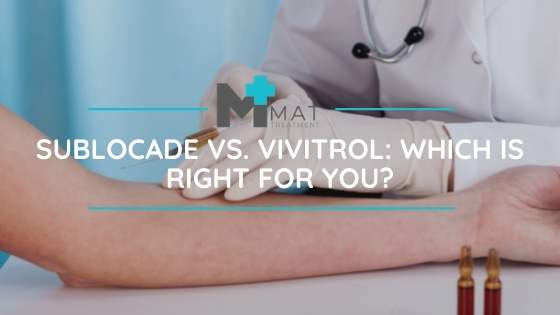Table of Contents
Medication-assisted treatment (MAT) is an effective means of opioid addiction treatment. MAT combats drug addiction at a chemical level. This gives patients a chance to work through the emotional aspects of addiction uninterrupted.
Suboxone and Naltrexone are the best-known MAT drugs, but they both carry a high risk of dependence. Two newer medications, Sublocade and Vivitrol, have a lower risk of secondary addiction.
What’s the difference between Sublocade and Vivitrol? Could either of them help you overcome your opioid addiction? Read on for a closer look at these two novel addiction treatments to find out whether Sublocade vs. Vivitrol is right for you.
Table of Contents
What Is Sublocade Treatment?
Sublocade is the brand-name for buprenorphine. It’s a highly-regulated prescription drug that combats opioid dependency.
Many doctors that used to prescribe Suboxone have switched over to Sublocade. Suboxone is another buprenorphine-based drug. However, Suboxone also contains naloxone and has to be taken more often.
Sublocade is a partial opioid agonist. It produces enough of the same physical effects that it’s able to ward off many withdrawal symptoms from heroin and other opioids. Even so, it isn’t addictive because it doesn’t create the same euphoric “high” as illicit or prescription opioids.
Sublocade Administration
One of the reasons Sublocade carries a lower risk of addiction is the absence of potential for misuse. Patients can’t administer this medication themselves. Instead, they must visit their doctor every 26 days for a subcutaneous injection.
Even so, long-term use of Sublocade can cause chemical dependence. You may experience mild withdrawal symptoms after stopping the medication. These symptoms tend to be less severe than those associated with Suboxone.
This medication comes in two extended-release formulas. Your doctor will recommend either the 300mg or 100mg dose based on the severity of your addiction and other factors.
Because Sublocade is an extended-release formula, patients have to go through a period of induction treatment. This happens during the first week to ten days of withdrawal. During induction treatment, patients take a different form of buprenorphine by mouth to ensure they won’t have any negative reactions to the injection later on.
Sublocade Side Effects
Like any medication, Sublocade does come with a risk of side effects. Irritation, swelling, and redness at the injection site are common. Many people who take Sublocade also experience the following:
- Stomach upset, nausea, or vomiting
- Fatigue and drowsiness
- Headaches and dizziness
- Constipation
These symptoms are often mild and will go away after the first few weeks. If they persist or get worse, let your doctor know. You should also seek immediate medical treatment if you notice:
- A significant drop in blood pressure
- Sudden, severe drowsiness or problems waking up
- Serious dizziness, unsteadiness, and/or fainting
- Rapid, slow, or irregular heartbeat
These can be signs of a severe, life-threatening reaction, so don’t try to wait them out on your own.
What Is Vivitrol Treatment?
Vivitrol is a unique medication because it not only treats opioid dependence but alcohol dependence as well. It contains Naltrexone, an opioid antagonist. This means that it blocks the brain’s pleasure receptors, preventing the “high” associated with opioids and alcohol.
Unlike Sublocade, though, it doesn’t lessen the symptoms of withdrawal. Vivitrol works because people are less likely to abuse alcohol and drugs if they can’t experience their pleasurable effects. It also helps reduce the intense chemical cravings that often lead to relapse.
Studies show that MAT with Vivitrol reduces heavy drinking and opioid abuse more than non-MAT programs. Using opioids while on Vivitrol can actually cause withdrawal symptoms, acting as a further deterrent. As such, Vivitrol makes patients more likely to complete a treatment program and stay engaged in their recovery.
Vivitrol Administration
Most naltrexone medications come in pill form. Vivitrol, on the other hand, is an intramuscular injection. Patients must see their physician once a month for administration.
Because taking Vivitrol with opioids in your system worsens withdrawal symptoms, patients can’t use this medication at the beginning of their treatment. Instead, they must first go through a complete medical detox. They can then start taking it after another week to ten days of sobriety.
Vivitrol Side Effects
Like Sublocade, many people experience some swelling or mild pain after getting their Vivitrol injection. They may also experience the following side effects of Vivitrol:
- Stomach upset, nausea, or decreased appetite
- Fatigue and drowsiness
- Headaches and dizziness
- Nervous or anxious mood
These side effects aren’t serious and should go away on their own. The following signs, however, indicate a serious negative reaction:
- A significant drop or spike in blood pressure
- Rapid, slow, or irregular heartbeat
- Injection site irritation turns into sores or blisters
- Slow or labored breathing
- Suicidal ideations or actions
Seek medical treatment immediately if you notice any of these symptoms.
Benefits of Sublocade and Vivitrol for Alcohol and Opioid Addiction Treatment
For the 2.1 million Americans with opioid use disorders, medication-assisted treatment can be life-changing. Its benefits include an improved patient survival rate, decreased illicit opiate use, improved birth outcomes, and an improved ability to maintain employment. With lessened cravings and withdrawal symptoms, patients can focus on developing healthy coping strategies and addressing emotional concerns.
Even so, MAT doesn’t work by itself. It’s only one part of an integrated recovery program. Individual therapy, support groups, and family counseling are also necessary pieces of the puzzle.
The goal of medications like Sublocade and Vivitrol isn’t to keep using them for life. Over time, your doctor will decrease the dosage until you no longer need to rely on them at all.
Talk to Your Doctor About Whether Sublocade vs. Vivitrol Is Right for You
Only your doctor can decide whether Sublocade vs. Vivitrol is right for you. If you want to know whether they could help in your journey to sobriety, talk with an addiction specialist today. They’ll help you break down the pros and cons of using each medication in your individual situation.
To learn more about medication-assisted treatment for alcohol and opioid addictions, keep reading through the other articles on our site.
Get Help Today
Don’t go through the process of recovery alone. There are people who can help you with the struggle you’re facing. Get in touch with one today.



